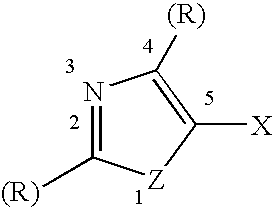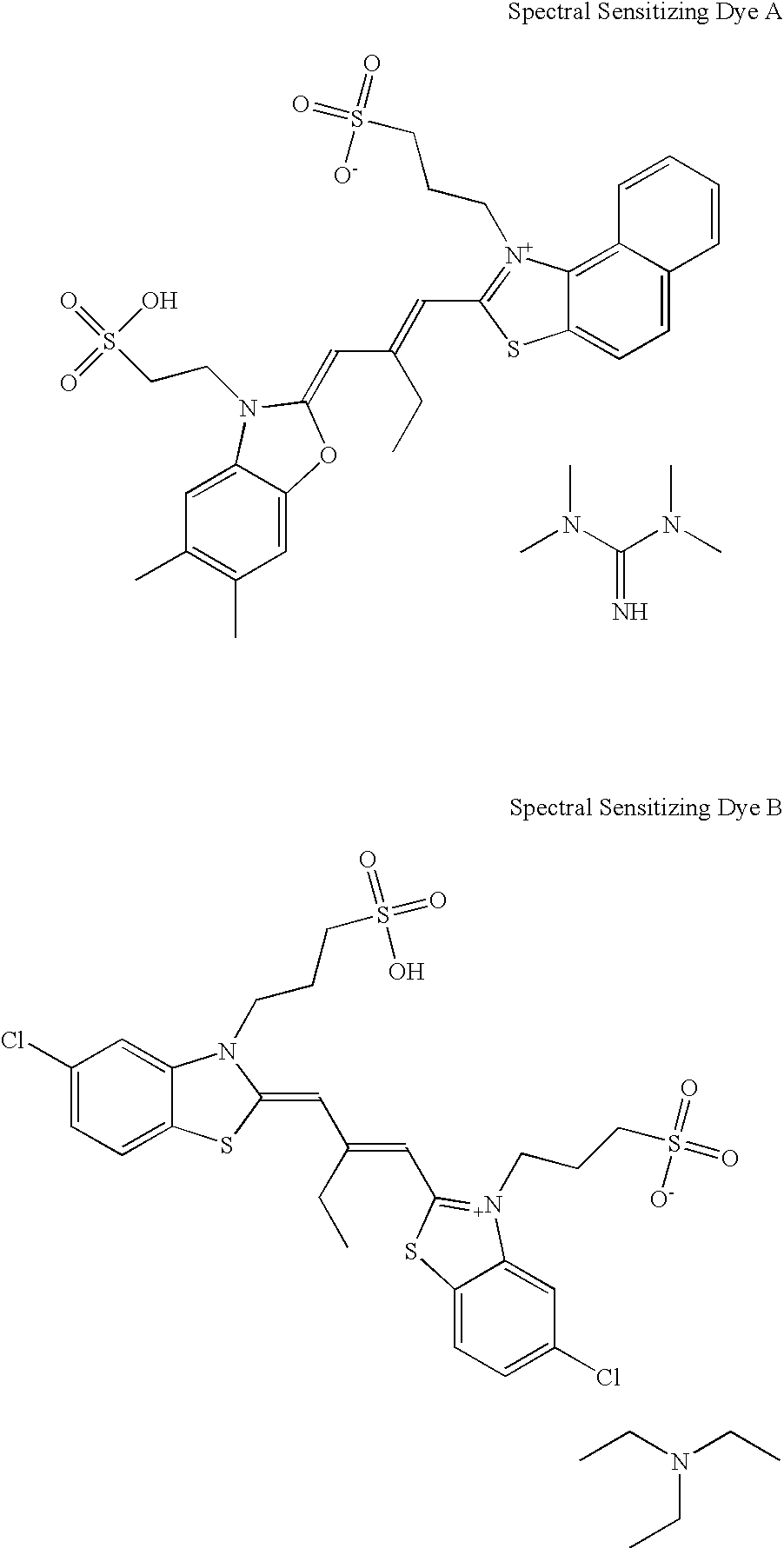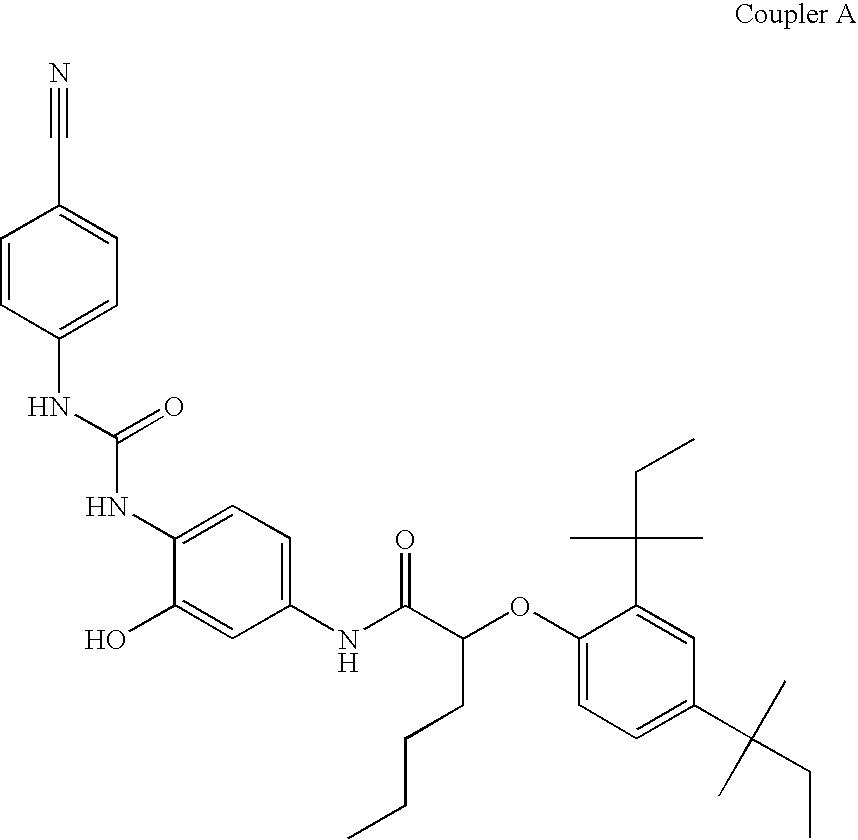Silver halide emulsion containing iridium dopant
a silver halide emulsion and iridium dopant technology, applied in the field of photography, can solve the problems of reduced reciprocity failure and reciprocity failure, and achieve the effects of improving reciprocity performance in silver halide emulsions, and reducing the impact of other aspects of photographic performan
- Summary
- Abstract
- Description
- Claims
- Application Information
AI Technical Summary
Benefits of technology
Problems solved by technology
Method used
Image
Examples
example 1
Emulsions for Color Negative Film
[0074]The following Examples 1.1, 1.2, 1.3 and 1.4 demonstrate the usefulness, in color negative film emulsions, of iridium dopants with one or more 5-halo substituted thiazole ligands, where the substituent at the 5 position is bromide or chloride. At least three of the remaining of the ligands on the iridium dopant are made up of halide or pseudohalides. One or two of the remaining ligands can be an other type of ligand. The examples show that the 5-position on the thiazole ring is a preferred position compared to the 2 or the 4 position, and further that the dopants [Cl5Ir(pyz)IrCl5]4− (Ex. H-4 of U.S. Pat. No. 5,360,712) and [IrCl6]3−, previously disclosed as a dopant for color negative film emulsions, are inferior to iridium dopants with 5-substituted thiazole ligands for reducing HIRF and LIRF with minimal speed loss.
[0075]For Examples 1.1–1.4, we evaluate 2.5 μm×0.128 μm AgBrI tabular grain emulsions (3.7 mole percent iodide, based on total si...
example 1.1
[0082]Here we compare photographic performance of those AgBrI tabular grain emulsions prepared as above and containing 25 ppb of an iridium dopant. In the control emulsion, water was used in place of any Ir dopant solution. We report the delta dmin [dmin(doped)−dmin(control)], the delta 0.15 spd [0.15 spd(doped)−0.15 spd(control)], % delta gamma (the effect of the dopant on maximum contrast), HIRF and LIRF in Table 1.1. The HIRF parameter was obtained for each emulsion by subtracting the 0.15 spd obtained for an exposure delivered over a time of 0.01s from the 0.15 spd obtained for an exposure of identical magnitude (same number of photons) delivered over a time of 0.0001s. A negative number is indicative of HIRF. Ideally, the HIRF parameter is 0. The LIRF parameter was obtained for each emulsion by subtracting the 0.15 spd obtained for an exposure delivered over a time of 0.01s from the 0.15 spd obtained for an exposure of identical magnitude (same number of photons) delivered over...
example 1.2
[0088]Here we examine the photographic performance of the AgBrI tabular grain emulsions, doped with [Ru(CN)6]4− and KSeCN, and additionally with [IrCl4(2-Br thiazole)2]1− or [IrCl4(5-Br thiazole)2]1−, and a control emulsion where water was used in place of any Ir dopant solution. The emulsions were sensitized with red sensitizing dye, sulfur and gold sensitized, and coated and tested as described above. The speed required to reach an optical density of 1.0 above dmin was measured, and recorded as 1.0 speed (1.0 spd). The contrast at a density of 1.0 above dmin was also measured for all emulsions. We report the delta 0.15 spd [0.15 spd(doped)−0.15 spd(control)], the delta 1.0 spd difference [1.0 spd(doped)−1.0 spd(control)], % delta contrast, HIRF and LIRF (as measured in Example 1.1) in Table 1.2. None of the dopants had a significant effect on dmin.
[0089]
TABLE 1.2IrDeltaDelta%level0.151.0DeltaEmulsion(ppb)DescriptionspdspdContrastHIRFLIRF1-A0—000−5−8(control)1-G-2325[IrCl4(2-Brtz)2...
PUM
| Property | Measurement | Unit |
|---|---|---|
| aspect ratio | aaaaa | aaaaa |
| temperatures | aaaaa | aaaaa |
| flow rate | aaaaa | aaaaa |
Abstract
Description
Claims
Application Information
 Login to View More
Login to View More - R&D
- Intellectual Property
- Life Sciences
- Materials
- Tech Scout
- Unparalleled Data Quality
- Higher Quality Content
- 60% Fewer Hallucinations
Browse by: Latest US Patents, China's latest patents, Technical Efficacy Thesaurus, Application Domain, Technology Topic, Popular Technical Reports.
© 2025 PatSnap. All rights reserved.Legal|Privacy policy|Modern Slavery Act Transparency Statement|Sitemap|About US| Contact US: help@patsnap.com



